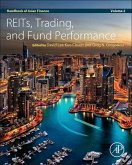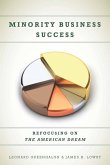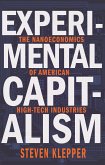Alberto Dávila, Marie T Mora
Hispanic Entrepreneurs in the 2000s
An Economic Profile and Policy Implications
Alberto Dávila, Marie T Mora
Hispanic Entrepreneurs in the 2000s
An Economic Profile and Policy Implications
- Gebundenes Buch
- Merkliste
- Auf die Merkliste
- Bewerten Bewerten
- Teilen
- Produkt teilen
- Produkterinnerung
- Produkterinnerung
Alberto D¿la is Professor of Economics and V.F. "Doc" and Gertrude Neuhaus Chair for Entrepreneurship at The University of Texas-Pan American. Marie T. Mora is Professor of Economics at The University of Texas-Pan American (UTPA). She serves on the Data Users Advisory Committee for the U.S. Bureau of Labor Statistics and the Board of the American Society of Hispanic Economists.
Andere Kunden interessierten sich auch für
![Handbook of Asian Finance Handbook of Asian Finance]() Handbook of Asian Finance163,99 €
Handbook of Asian Finance163,99 €![Handbook of Asian Finance Handbook of Asian Finance]() Handbook of Asian Finance165,99 €
Handbook of Asian Finance165,99 €![Minority Business Success Minority Business Success]() Leonard GreenhalghMinority Business Success140,99 €
Leonard GreenhalghMinority Business Success140,99 €![Upgrading China's Information and Communication Technology Industry: State-Firm Strategic Coordination and the Geography of Technological Innovation Upgrading China's Information and Communication Technology Industry: State-Firm Strategic Coordination and the Geography of Technological Innovation]() Cassandra C WangUpgrading China's Information and Communication Technology Industry: State-Firm Strategic Coordination and the Geography of Technological Innovation133,99 €
Cassandra C WangUpgrading China's Information and Communication Technology Industry: State-Firm Strategic Coordination and the Geography of Technological Innovation133,99 €![Experimental Capitalism Experimental Capitalism]() Steven KlepperExperimental Capitalism55,99 €
Steven KlepperExperimental Capitalism55,99 €![Owning the Sun: A People's History of Monopoly Medicine from Aspirin to Covid-19 Vaccines Owning the Sun: A People's History of Monopoly Medicine from Aspirin to Covid-19 Vaccines]() Alexander ZaitchikOwning the Sun: A People's History of Monopoly Medicine from Aspirin to Covid-19 Vaccines23,99 €
Alexander ZaitchikOwning the Sun: A People's History of Monopoly Medicine from Aspirin to Covid-19 Vaccines23,99 €![The Globalisation of Indian Business The Globalisation of Indian Business]() Beena SaraswathyThe Globalisation of Indian Business204,99 €
Beena SaraswathyThe Globalisation of Indian Business204,99 €-
-
-
Alberto D¿la is Professor of Economics and V.F. "Doc" and Gertrude Neuhaus Chair for Entrepreneurship at The University of Texas-Pan American. Marie T. Mora is Professor of Economics at The University of Texas-Pan American (UTPA). She serves on the Data Users Advisory Committee for the U.S. Bureau of Labor Statistics and the Board of the American Society of Hispanic Economists.
Hinweis: Dieser Artikel kann nur an eine deutsche Lieferadresse ausgeliefert werden.
Hinweis: Dieser Artikel kann nur an eine deutsche Lieferadresse ausgeliefert werden.
Produktdetails
- Produktdetails
- Verlag: Stanford University Press
- Seitenzahl: 256
- Erscheinungstermin: 16. Oktober 2013
- Englisch
- Abmessung: 231mm x 160mm x 20mm
- Gewicht: 476g
- ISBN-13: 9780804777933
- ISBN-10: 0804777934
- Artikelnr.: 38151909
- Herstellerkennzeichnung
- Libri GmbH
- Europaallee 1
- 36244 Bad Hersfeld
- 06621 890
- Verlag: Stanford University Press
- Seitenzahl: 256
- Erscheinungstermin: 16. Oktober 2013
- Englisch
- Abmessung: 231mm x 160mm x 20mm
- Gewicht: 476g
- ISBN-13: 9780804777933
- ISBN-10: 0804777934
- Artikelnr.: 38151909
- Herstellerkennzeichnung
- Libri GmbH
- Europaallee 1
- 36244 Bad Hersfeld
- 06621 890
Alberto Dávila is Professor of Economics and V.F. "Doc" and Gertrude Neuhaus Chair for Entrepreneurship at The University of Texas-Pan American. Marie T. Mora is Professor of Economics at The University of Texas-Pan American (UTPA). She serves on the Data Users Advisory Committee for the U.S. Bureau of Labor Statistics and the Board of the American Society of Hispanic Economists.
> Hispanic Entrepreneurs in the 2000s: An Economic Profile and Policy
Implications
Author(s): Alberto Dávila and Marie T. Mora
This book provides an in-depth economic and policy analysis of Hispanic
entrepreneurs in the first decade of the 2000s. This book captures a flavor
of issues related to the business cycle, economic outcomes (such as
employment, sales, and contributions to tax coffers), socio-demographic
characteristics, access to financial capital, the use and importance of
digital technology, and public procurement and other policies affecting
Hispanic business owners in the early 2000s. One distinguishing feature of
this book is that it provides a comprehensive empirical analysis of many of
these issues for specific Hispanic populations, such as men versus women,
immigrants versus natives, and across Hispanic sub-groups (Mexican
Americans, Puerto Ricans, Cubans, and Salvadorans). The first decade of the
2000s witnessed the dramatic growth in the Hispanic population and the
intensification of their entrepreneurial tendencies. If these demographic
changes continue as the 2000s unfold, Hispanic entrepreneurship will become
an increasingly vital component of American job creation and to the
economic direction of the nation.
> 1
A Macro View of Hispanic Self-Employment in the 2000s
Chapter abstract:
This chapter provides an overview of the changing entrepreneurial
tendencies among the Hispanic population in the first decade of the 2000s,
which sets the stage for more detailed topics discussed later in the book.
In particular, the chapter points out that the growing size of the Hispanic
population as well as rising self-employment rates explain the recent
growth in in the number of Hispanic-owned businesses. This chapter also
presents information on the heterogeneity of the Hispanic population by
highlighting the differences that existed across regions, industries, and
ethnic subgroups. In addition, the chapter makes note of the importance of
the business cycle when studying Hispanic entrepreneurship.
> 2
Entrepreneurial Earnings of Hispanics in the 2000s
Chapter abstract:
This chapter first outlines the self-employment "push-pull" framework and
provides insight into the impact of an increasing entrepreneurial base on
the talent and skills of Hispanic entrepreneurs. As part of the discussion,
the chapter includes an analysis of the sales and profits of Hispanic-owned
firms, as well as changes in the relative earnings of self-employed
Hispanics during the first decade of the 2000s (particularly before and
after the Great Recession). The issue of how entrepreneurial earnings
changed for the largest Hispanic ethnic subgroups and for workers in the
construction industry versus other industries is also explored.
> 3
Hispanic Immigrant Entrepreneurs
Chapter abstract:
This chapter highlights that a large part of the story behind Hispanic
entrepreneurship in the 2000s involved Hispanic immigrants. As part of the
discussion, the chapter points out that Hispanic-immigrant entrepreneurs
added significant value to the U.S. economy in first decade of the 2000s.
It also analyzes the differences in sales between firms owned by
foreign-born and U.S.-born Hispanics as well as how demographic
characteristics (including ethnic origin, industry distributions, and the
geographic concentrations of self-employed Hispanic immigrants) changed in
the first decade of the 2000s. Issues related to self-selection are further
considered, as are the contributions of Hispanic-immigrant-owned businesses
to government coffers.
> 4
Education and Hispanic Entrepreneurs
Chapter abstract:
Given their relatively low educational attainment, and given the recent
increase in the number of Hispanic-owned businesses, the extent to which
education matters for the business and earnings outcomes of Hispanic
entrepreneurs has increasingly important implications for the future
development of the United States. This chapter thus analyzes the
relationship of education to sales of Hispanic-owned businesses, taking
business owners' birthplace into account. The chapter further analyzes how
the relationship between education and the earnings of Hispanic
entrepreneurs changed during the Great Recession, including across the
distribution of earnings, across Hispanic subgroups, and between natives
and immigrants. The chapter concludes with an investigation into how
education is related to entry into the self-employment sector.
> 5
Hispanic Female Entrepreneurs
Chapter abstract:
Given that one-third of all Hispanic-owned businesses are owned by women,
this chapter focuses on gender-related differences in business outcomes and
self-employment earnings among Hispanic entrepreneurs. Hispanic female
entrepreneurs appear to be at a relative disadvantage compared to their
male counterparts with respect to a variety of outcomes (including sales,
the likelihood of having paid-employees, the likelihood of being a
microentrepreneur, and earnings). Nevertheless, through additional
comparisons between foreign-born and U.S.-born entrepreneurs, the chapter
points to the presence of stronger self-employment "pull" versus "push"
conditions for female Hispanic natives than for immigrants. The chapter
concludes with a discussion of policy implications.
> 6
Strategic Issues for Hispanic Entrepreneurs-Credit Access
Chapter abstract:
This chapter addresses how Hispanic entrepreneurs fared with regards to
accessing credit in the first decade of the 2000s. Hispanic entrepreneurs
were more likely than their non-Hispanic counterparts to report the
inability to acquire the financial capital they needed to expand or improve
their operations; they also appeared to face other credit-access barriers
in the form of relatively small loan amounts and high interest rates. In
addition to considering the role of discrimination, this chapter discusses
how these findings could relate to cultural forces, including how Hispanics
seem to be relatively conservative in their credit demands and less likely
to trust traditional methods of financing, such as bank loans.
> 7
Strategic Issues for Hispanic Entrepreneurs-Technology Usage
Chapter abstract:
This chapter explores whether Hispanic entrepreneurs use digital technology
differently than their non-Hispanic counterparts. It also analyzes whether
the usage of such technology related to business outcomes between Hispanic-
and non-Hispanic-owned small firms. The findings are mixed. One dataset
indicates the presence of a digital divide between Hispanic and
non-Hispanic entrepreneurs with respect to having a website and conducting
e-commerce, although differences in observable characteristics explained a
considerable portion of this gap. However, an alternative dataset suggests
that the digital divide that existed between Hispanic- and
non-Hispanic-owned small businesses in the late 1990s had vanished by the
mid-2000s.
> 8
Current Policy Issues for Hispanic Entrepreneurs
Chapter abstract:
This chapter addresses a variety of policy issues pertaining to Hispanic
entrepreneurship. It begins with a cursory data analysis that suggests the
existence of potential untapped opportunities for Hispanic entrepreneurs
because they either lack awareness about existing programs or are reluctant
to use them. The chapter then discusses issues that have shaped (and might
continue to shape) Hispanic entrepreneurship, from public policy and
private-sector perspectives to changing demographic trends across the
country. The chapter also provides a critical assessment of policy-related
issues facing Hispanic entrepreneurs, such as those pertaining to
government procurement, firm size, credit access (such as the "SBA 7(a)"
loan program); education, immigration (including the "EB-5" visa program),
and statistical discrimination.
> 9
In Closing
Chapter abstract:
This chapter provides a summary of many of the key issues pertaining to
Hispanic entrepreneurship raised throughout the book, including the
business cycle, economic outcomes, socio-demographic characteristics,
access to financial and physical capital, and policy and conceptual issues
that Hispanic business owners faced in the first decade of this millennium.
As discussed throughout the book, that decade witnessed dramatic growth in
the Hispanic population and the intensification of entrepreneurial
tendencies among Hispanics. If these demographic changes continue, Hispanic
entrepreneurship will become an increasingly vital component of American
job creation and the economic direction of the nation.
Implications
Author(s): Alberto Dávila and Marie T. Mora
This book provides an in-depth economic and policy analysis of Hispanic
entrepreneurs in the first decade of the 2000s. This book captures a flavor
of issues related to the business cycle, economic outcomes (such as
employment, sales, and contributions to tax coffers), socio-demographic
characteristics, access to financial capital, the use and importance of
digital technology, and public procurement and other policies affecting
Hispanic business owners in the early 2000s. One distinguishing feature of
this book is that it provides a comprehensive empirical analysis of many of
these issues for specific Hispanic populations, such as men versus women,
immigrants versus natives, and across Hispanic sub-groups (Mexican
Americans, Puerto Ricans, Cubans, and Salvadorans). The first decade of the
2000s witnessed the dramatic growth in the Hispanic population and the
intensification of their entrepreneurial tendencies. If these demographic
changes continue as the 2000s unfold, Hispanic entrepreneurship will become
an increasingly vital component of American job creation and to the
economic direction of the nation.
> 1
A Macro View of Hispanic Self-Employment in the 2000s
Chapter abstract:
This chapter provides an overview of the changing entrepreneurial
tendencies among the Hispanic population in the first decade of the 2000s,
which sets the stage for more detailed topics discussed later in the book.
In particular, the chapter points out that the growing size of the Hispanic
population as well as rising self-employment rates explain the recent
growth in in the number of Hispanic-owned businesses. This chapter also
presents information on the heterogeneity of the Hispanic population by
highlighting the differences that existed across regions, industries, and
ethnic subgroups. In addition, the chapter makes note of the importance of
the business cycle when studying Hispanic entrepreneurship.
> 2
Entrepreneurial Earnings of Hispanics in the 2000s
Chapter abstract:
This chapter first outlines the self-employment "push-pull" framework and
provides insight into the impact of an increasing entrepreneurial base on
the talent and skills of Hispanic entrepreneurs. As part of the discussion,
the chapter includes an analysis of the sales and profits of Hispanic-owned
firms, as well as changes in the relative earnings of self-employed
Hispanics during the first decade of the 2000s (particularly before and
after the Great Recession). The issue of how entrepreneurial earnings
changed for the largest Hispanic ethnic subgroups and for workers in the
construction industry versus other industries is also explored.
> 3
Hispanic Immigrant Entrepreneurs
Chapter abstract:
This chapter highlights that a large part of the story behind Hispanic
entrepreneurship in the 2000s involved Hispanic immigrants. As part of the
discussion, the chapter points out that Hispanic-immigrant entrepreneurs
added significant value to the U.S. economy in first decade of the 2000s.
It also analyzes the differences in sales between firms owned by
foreign-born and U.S.-born Hispanics as well as how demographic
characteristics (including ethnic origin, industry distributions, and the
geographic concentrations of self-employed Hispanic immigrants) changed in
the first decade of the 2000s. Issues related to self-selection are further
considered, as are the contributions of Hispanic-immigrant-owned businesses
to government coffers.
> 4
Education and Hispanic Entrepreneurs
Chapter abstract:
Given their relatively low educational attainment, and given the recent
increase in the number of Hispanic-owned businesses, the extent to which
education matters for the business and earnings outcomes of Hispanic
entrepreneurs has increasingly important implications for the future
development of the United States. This chapter thus analyzes the
relationship of education to sales of Hispanic-owned businesses, taking
business owners' birthplace into account. The chapter further analyzes how
the relationship between education and the earnings of Hispanic
entrepreneurs changed during the Great Recession, including across the
distribution of earnings, across Hispanic subgroups, and between natives
and immigrants. The chapter concludes with an investigation into how
education is related to entry into the self-employment sector.
> 5
Hispanic Female Entrepreneurs
Chapter abstract:
Given that one-third of all Hispanic-owned businesses are owned by women,
this chapter focuses on gender-related differences in business outcomes and
self-employment earnings among Hispanic entrepreneurs. Hispanic female
entrepreneurs appear to be at a relative disadvantage compared to their
male counterparts with respect to a variety of outcomes (including sales,
the likelihood of having paid-employees, the likelihood of being a
microentrepreneur, and earnings). Nevertheless, through additional
comparisons between foreign-born and U.S.-born entrepreneurs, the chapter
points to the presence of stronger self-employment "pull" versus "push"
conditions for female Hispanic natives than for immigrants. The chapter
concludes with a discussion of policy implications.
> 6
Strategic Issues for Hispanic Entrepreneurs-Credit Access
Chapter abstract:
This chapter addresses how Hispanic entrepreneurs fared with regards to
accessing credit in the first decade of the 2000s. Hispanic entrepreneurs
were more likely than their non-Hispanic counterparts to report the
inability to acquire the financial capital they needed to expand or improve
their operations; they also appeared to face other credit-access barriers
in the form of relatively small loan amounts and high interest rates. In
addition to considering the role of discrimination, this chapter discusses
how these findings could relate to cultural forces, including how Hispanics
seem to be relatively conservative in their credit demands and less likely
to trust traditional methods of financing, such as bank loans.
> 7
Strategic Issues for Hispanic Entrepreneurs-Technology Usage
Chapter abstract:
This chapter explores whether Hispanic entrepreneurs use digital technology
differently than their non-Hispanic counterparts. It also analyzes whether
the usage of such technology related to business outcomes between Hispanic-
and non-Hispanic-owned small firms. The findings are mixed. One dataset
indicates the presence of a digital divide between Hispanic and
non-Hispanic entrepreneurs with respect to having a website and conducting
e-commerce, although differences in observable characteristics explained a
considerable portion of this gap. However, an alternative dataset suggests
that the digital divide that existed between Hispanic- and
non-Hispanic-owned small businesses in the late 1990s had vanished by the
mid-2000s.
> 8
Current Policy Issues for Hispanic Entrepreneurs
Chapter abstract:
This chapter addresses a variety of policy issues pertaining to Hispanic
entrepreneurship. It begins with a cursory data analysis that suggests the
existence of potential untapped opportunities for Hispanic entrepreneurs
because they either lack awareness about existing programs or are reluctant
to use them. The chapter then discusses issues that have shaped (and might
continue to shape) Hispanic entrepreneurship, from public policy and
private-sector perspectives to changing demographic trends across the
country. The chapter also provides a critical assessment of policy-related
issues facing Hispanic entrepreneurs, such as those pertaining to
government procurement, firm size, credit access (such as the "SBA 7(a)"
loan program); education, immigration (including the "EB-5" visa program),
and statistical discrimination.
> 9
In Closing
Chapter abstract:
This chapter provides a summary of many of the key issues pertaining to
Hispanic entrepreneurship raised throughout the book, including the
business cycle, economic outcomes, socio-demographic characteristics,
access to financial and physical capital, and policy and conceptual issues
that Hispanic business owners faced in the first decade of this millennium.
As discussed throughout the book, that decade witnessed dramatic growth in
the Hispanic population and the intensification of entrepreneurial
tendencies among Hispanics. If these demographic changes continue, Hispanic
entrepreneurship will become an increasingly vital component of American
job creation and the economic direction of the nation.
> Hispanic Entrepreneurs in the 2000s: An Economic Profile and Policy
Implications
Author(s): Alberto Dávila and Marie T. Mora
This book provides an in-depth economic and policy analysis of Hispanic
entrepreneurs in the first decade of the 2000s. This book captures a flavor
of issues related to the business cycle, economic outcomes (such as
employment, sales, and contributions to tax coffers), socio-demographic
characteristics, access to financial capital, the use and importance of
digital technology, and public procurement and other policies affecting
Hispanic business owners in the early 2000s. One distinguishing feature of
this book is that it provides a comprehensive empirical analysis of many of
these issues for specific Hispanic populations, such as men versus women,
immigrants versus natives, and across Hispanic sub-groups (Mexican
Americans, Puerto Ricans, Cubans, and Salvadorans). The first decade of the
2000s witnessed the dramatic growth in the Hispanic population and the
intensification of their entrepreneurial tendencies. If these demographic
changes continue as the 2000s unfold, Hispanic entrepreneurship will become
an increasingly vital component of American job creation and to the
economic direction of the nation.
> 1
A Macro View of Hispanic Self-Employment in the 2000s
Chapter abstract:
This chapter provides an overview of the changing entrepreneurial
tendencies among the Hispanic population in the first decade of the 2000s,
which sets the stage for more detailed topics discussed later in the book.
In particular, the chapter points out that the growing size of the Hispanic
population as well as rising self-employment rates explain the recent
growth in in the number of Hispanic-owned businesses. This chapter also
presents information on the heterogeneity of the Hispanic population by
highlighting the differences that existed across regions, industries, and
ethnic subgroups. In addition, the chapter makes note of the importance of
the business cycle when studying Hispanic entrepreneurship.
> 2
Entrepreneurial Earnings of Hispanics in the 2000s
Chapter abstract:
This chapter first outlines the self-employment "push-pull" framework and
provides insight into the impact of an increasing entrepreneurial base on
the talent and skills of Hispanic entrepreneurs. As part of the discussion,
the chapter includes an analysis of the sales and profits of Hispanic-owned
firms, as well as changes in the relative earnings of self-employed
Hispanics during the first decade of the 2000s (particularly before and
after the Great Recession). The issue of how entrepreneurial earnings
changed for the largest Hispanic ethnic subgroups and for workers in the
construction industry versus other industries is also explored.
> 3
Hispanic Immigrant Entrepreneurs
Chapter abstract:
This chapter highlights that a large part of the story behind Hispanic
entrepreneurship in the 2000s involved Hispanic immigrants. As part of the
discussion, the chapter points out that Hispanic-immigrant entrepreneurs
added significant value to the U.S. economy in first decade of the 2000s.
It also analyzes the differences in sales between firms owned by
foreign-born and U.S.-born Hispanics as well as how demographic
characteristics (including ethnic origin, industry distributions, and the
geographic concentrations of self-employed Hispanic immigrants) changed in
the first decade of the 2000s. Issues related to self-selection are further
considered, as are the contributions of Hispanic-immigrant-owned businesses
to government coffers.
> 4
Education and Hispanic Entrepreneurs
Chapter abstract:
Given their relatively low educational attainment, and given the recent
increase in the number of Hispanic-owned businesses, the extent to which
education matters for the business and earnings outcomes of Hispanic
entrepreneurs has increasingly important implications for the future
development of the United States. This chapter thus analyzes the
relationship of education to sales of Hispanic-owned businesses, taking
business owners' birthplace into account. The chapter further analyzes how
the relationship between education and the earnings of Hispanic
entrepreneurs changed during the Great Recession, including across the
distribution of earnings, across Hispanic subgroups, and between natives
and immigrants. The chapter concludes with an investigation into how
education is related to entry into the self-employment sector.
> 5
Hispanic Female Entrepreneurs
Chapter abstract:
Given that one-third of all Hispanic-owned businesses are owned by women,
this chapter focuses on gender-related differences in business outcomes and
self-employment earnings among Hispanic entrepreneurs. Hispanic female
entrepreneurs appear to be at a relative disadvantage compared to their
male counterparts with respect to a variety of outcomes (including sales,
the likelihood of having paid-employees, the likelihood of being a
microentrepreneur, and earnings). Nevertheless, through additional
comparisons between foreign-born and U.S.-born entrepreneurs, the chapter
points to the presence of stronger self-employment "pull" versus "push"
conditions for female Hispanic natives than for immigrants. The chapter
concludes with a discussion of policy implications.
> 6
Strategic Issues for Hispanic Entrepreneurs-Credit Access
Chapter abstract:
This chapter addresses how Hispanic entrepreneurs fared with regards to
accessing credit in the first decade of the 2000s. Hispanic entrepreneurs
were more likely than their non-Hispanic counterparts to report the
inability to acquire the financial capital they needed to expand or improve
their operations; they also appeared to face other credit-access barriers
in the form of relatively small loan amounts and high interest rates. In
addition to considering the role of discrimination, this chapter discusses
how these findings could relate to cultural forces, including how Hispanics
seem to be relatively conservative in their credit demands and less likely
to trust traditional methods of financing, such as bank loans.
> 7
Strategic Issues for Hispanic Entrepreneurs-Technology Usage
Chapter abstract:
This chapter explores whether Hispanic entrepreneurs use digital technology
differently than their non-Hispanic counterparts. It also analyzes whether
the usage of such technology related to business outcomes between Hispanic-
and non-Hispanic-owned small firms. The findings are mixed. One dataset
indicates the presence of a digital divide between Hispanic and
non-Hispanic entrepreneurs with respect to having a website and conducting
e-commerce, although differences in observable characteristics explained a
considerable portion of this gap. However, an alternative dataset suggests
that the digital divide that existed between Hispanic- and
non-Hispanic-owned small businesses in the late 1990s had vanished by the
mid-2000s.
> 8
Current Policy Issues for Hispanic Entrepreneurs
Chapter abstract:
This chapter addresses a variety of policy issues pertaining to Hispanic
entrepreneurship. It begins with a cursory data analysis that suggests the
existence of potential untapped opportunities for Hispanic entrepreneurs
because they either lack awareness about existing programs or are reluctant
to use them. The chapter then discusses issues that have shaped (and might
continue to shape) Hispanic entrepreneurship, from public policy and
private-sector perspectives to changing demographic trends across the
country. The chapter also provides a critical assessment of policy-related
issues facing Hispanic entrepreneurs, such as those pertaining to
government procurement, firm size, credit access (such as the "SBA 7(a)"
loan program); education, immigration (including the "EB-5" visa program),
and statistical discrimination.
> 9
In Closing
Chapter abstract:
This chapter provides a summary of many of the key issues pertaining to
Hispanic entrepreneurship raised throughout the book, including the
business cycle, economic outcomes, socio-demographic characteristics,
access to financial and physical capital, and policy and conceptual issues
that Hispanic business owners faced in the first decade of this millennium.
As discussed throughout the book, that decade witnessed dramatic growth in
the Hispanic population and the intensification of entrepreneurial
tendencies among Hispanics. If these demographic changes continue, Hispanic
entrepreneurship will become an increasingly vital component of American
job creation and the economic direction of the nation.
Implications
Author(s): Alberto Dávila and Marie T. Mora
This book provides an in-depth economic and policy analysis of Hispanic
entrepreneurs in the first decade of the 2000s. This book captures a flavor
of issues related to the business cycle, economic outcomes (such as
employment, sales, and contributions to tax coffers), socio-demographic
characteristics, access to financial capital, the use and importance of
digital technology, and public procurement and other policies affecting
Hispanic business owners in the early 2000s. One distinguishing feature of
this book is that it provides a comprehensive empirical analysis of many of
these issues for specific Hispanic populations, such as men versus women,
immigrants versus natives, and across Hispanic sub-groups (Mexican
Americans, Puerto Ricans, Cubans, and Salvadorans). The first decade of the
2000s witnessed the dramatic growth in the Hispanic population and the
intensification of their entrepreneurial tendencies. If these demographic
changes continue as the 2000s unfold, Hispanic entrepreneurship will become
an increasingly vital component of American job creation and to the
economic direction of the nation.
> 1
A Macro View of Hispanic Self-Employment in the 2000s
Chapter abstract:
This chapter provides an overview of the changing entrepreneurial
tendencies among the Hispanic population in the first decade of the 2000s,
which sets the stage for more detailed topics discussed later in the book.
In particular, the chapter points out that the growing size of the Hispanic
population as well as rising self-employment rates explain the recent
growth in in the number of Hispanic-owned businesses. This chapter also
presents information on the heterogeneity of the Hispanic population by
highlighting the differences that existed across regions, industries, and
ethnic subgroups. In addition, the chapter makes note of the importance of
the business cycle when studying Hispanic entrepreneurship.
> 2
Entrepreneurial Earnings of Hispanics in the 2000s
Chapter abstract:
This chapter first outlines the self-employment "push-pull" framework and
provides insight into the impact of an increasing entrepreneurial base on
the talent and skills of Hispanic entrepreneurs. As part of the discussion,
the chapter includes an analysis of the sales and profits of Hispanic-owned
firms, as well as changes in the relative earnings of self-employed
Hispanics during the first decade of the 2000s (particularly before and
after the Great Recession). The issue of how entrepreneurial earnings
changed for the largest Hispanic ethnic subgroups and for workers in the
construction industry versus other industries is also explored.
> 3
Hispanic Immigrant Entrepreneurs
Chapter abstract:
This chapter highlights that a large part of the story behind Hispanic
entrepreneurship in the 2000s involved Hispanic immigrants. As part of the
discussion, the chapter points out that Hispanic-immigrant entrepreneurs
added significant value to the U.S. economy in first decade of the 2000s.
It also analyzes the differences in sales between firms owned by
foreign-born and U.S.-born Hispanics as well as how demographic
characteristics (including ethnic origin, industry distributions, and the
geographic concentrations of self-employed Hispanic immigrants) changed in
the first decade of the 2000s. Issues related to self-selection are further
considered, as are the contributions of Hispanic-immigrant-owned businesses
to government coffers.
> 4
Education and Hispanic Entrepreneurs
Chapter abstract:
Given their relatively low educational attainment, and given the recent
increase in the number of Hispanic-owned businesses, the extent to which
education matters for the business and earnings outcomes of Hispanic
entrepreneurs has increasingly important implications for the future
development of the United States. This chapter thus analyzes the
relationship of education to sales of Hispanic-owned businesses, taking
business owners' birthplace into account. The chapter further analyzes how
the relationship between education and the earnings of Hispanic
entrepreneurs changed during the Great Recession, including across the
distribution of earnings, across Hispanic subgroups, and between natives
and immigrants. The chapter concludes with an investigation into how
education is related to entry into the self-employment sector.
> 5
Hispanic Female Entrepreneurs
Chapter abstract:
Given that one-third of all Hispanic-owned businesses are owned by women,
this chapter focuses on gender-related differences in business outcomes and
self-employment earnings among Hispanic entrepreneurs. Hispanic female
entrepreneurs appear to be at a relative disadvantage compared to their
male counterparts with respect to a variety of outcomes (including sales,
the likelihood of having paid-employees, the likelihood of being a
microentrepreneur, and earnings). Nevertheless, through additional
comparisons between foreign-born and U.S.-born entrepreneurs, the chapter
points to the presence of stronger self-employment "pull" versus "push"
conditions for female Hispanic natives than for immigrants. The chapter
concludes with a discussion of policy implications.
> 6
Strategic Issues for Hispanic Entrepreneurs-Credit Access
Chapter abstract:
This chapter addresses how Hispanic entrepreneurs fared with regards to
accessing credit in the first decade of the 2000s. Hispanic entrepreneurs
were more likely than their non-Hispanic counterparts to report the
inability to acquire the financial capital they needed to expand or improve
their operations; they also appeared to face other credit-access barriers
in the form of relatively small loan amounts and high interest rates. In
addition to considering the role of discrimination, this chapter discusses
how these findings could relate to cultural forces, including how Hispanics
seem to be relatively conservative in their credit demands and less likely
to trust traditional methods of financing, such as bank loans.
> 7
Strategic Issues for Hispanic Entrepreneurs-Technology Usage
Chapter abstract:
This chapter explores whether Hispanic entrepreneurs use digital technology
differently than their non-Hispanic counterparts. It also analyzes whether
the usage of such technology related to business outcomes between Hispanic-
and non-Hispanic-owned small firms. The findings are mixed. One dataset
indicates the presence of a digital divide between Hispanic and
non-Hispanic entrepreneurs with respect to having a website and conducting
e-commerce, although differences in observable characteristics explained a
considerable portion of this gap. However, an alternative dataset suggests
that the digital divide that existed between Hispanic- and
non-Hispanic-owned small businesses in the late 1990s had vanished by the
mid-2000s.
> 8
Current Policy Issues for Hispanic Entrepreneurs
Chapter abstract:
This chapter addresses a variety of policy issues pertaining to Hispanic
entrepreneurship. It begins with a cursory data analysis that suggests the
existence of potential untapped opportunities for Hispanic entrepreneurs
because they either lack awareness about existing programs or are reluctant
to use them. The chapter then discusses issues that have shaped (and might
continue to shape) Hispanic entrepreneurship, from public policy and
private-sector perspectives to changing demographic trends across the
country. The chapter also provides a critical assessment of policy-related
issues facing Hispanic entrepreneurs, such as those pertaining to
government procurement, firm size, credit access (such as the "SBA 7(a)"
loan program); education, immigration (including the "EB-5" visa program),
and statistical discrimination.
> 9
In Closing
Chapter abstract:
This chapter provides a summary of many of the key issues pertaining to
Hispanic entrepreneurship raised throughout the book, including the
business cycle, economic outcomes, socio-demographic characteristics,
access to financial and physical capital, and policy and conceptual issues
that Hispanic business owners faced in the first decade of this millennium.
As discussed throughout the book, that decade witnessed dramatic growth in
the Hispanic population and the intensification of entrepreneurial
tendencies among Hispanics. If these demographic changes continue, Hispanic
entrepreneurship will become an increasingly vital component of American
job creation and the economic direction of the nation.








